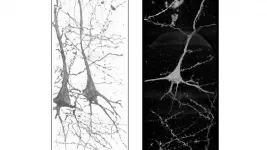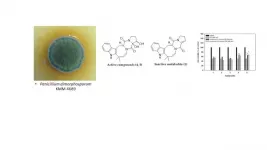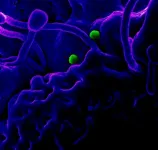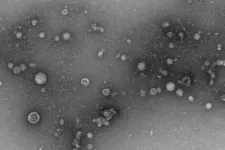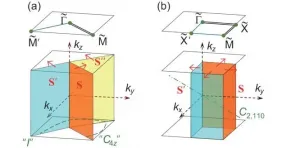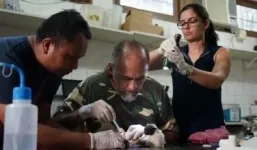(Press-News.org) Schizophrenia, a chronic, neurological brain disorder, affects millions of people around the world. It causes a fracture between a person's thoughts, feelings and behavior. Symptoms include delusions, hallucinations, difficulty processing thoughts and an overall lack of motivation. Schizophrenia patients have a higher suicide rate and more health problems than the general population, and a lower life expectancy.
There is no cure for schizophrenia, but the key to treating it more effectively is to better understand how it arises. And that, according to Ryuta Mizutani, professor of applied biochemistry at Tokai University in Japan, means studying the structure of brain tissue. Specifically, it means comparing the brain tissues of schizophrenia patients with those of people in good mental health, to see the differences as clearly as possible.
"There are only a few places in the world where you can do this research. Without 3D analysis of brain tissues this work would not be possible." -- Ryuta Mizutani, professor, Tokai University
"The current treatment for schizophrenia is based on many hypotheses we don't know how to confirm," Mizutani said. "The first step is to analyze the brain and see how it is constituted differently."
To do that, Mizutani and his colleagues from several international institutions collected eight small samples of brain tissue -- four from healthy brains and four from those of schizophrenia patients, all collected post-mortem -- and brought them to beamline 32-ID of the Advanced Photon Source (APS), a U.S. Department of Energy (DOE) Office of Science User Facility at DOE's Argonne National Laboratory.
At the APS, the team used powerful X-rays and high-resolution optics to capture three-dimensional images of those tissues. (Researchers collected similar images at the Super Photon Ring 8-GeV [SPring-8] light source facility in Japan.) The resolution of the X-ray optics used at the APS can be as high as 10 nanometers. That's about 700 times smaller than the width of the average red blood cell, and there are five million of those cells in a drop of blood.
"There are only a few places in the world where you can do this research," Mizutani said. "Without 3D analysis of brain tissues this work would not be possible."
According to Vincent De Andrade, physicist in Argonne's X-ray Science Division, capturing images at high resolution presents a challenge, since the neurons being imaged can be centimeters long. The neuron is the basic working unit of the brain, a cell within the nervous system that transmits information to other cells to control body functions. The human brain has roughly 100 billion of these neurons, in various sizes and shapes.
"The sample has to move through the X-ray beam to trace the neurons through the sample," De Andrade explained. "The field of view of our X-ray microscope is about 50 microns, about the width of a human hair, and you need to follow these neurons over several millimeters."
What these images showed is that the structures of these neurons are uniquely different in each schizophrenia patient, which Mizutani said is evidence that the disease is associated with those structures. Images of healthy neurons were relatively similar, while neurons from schizophrenia patients showed far more deviation, both from the healthy brains and from each other.
More study is needed, Mizutani said, to figure out exactly how the structures of neurons are related to the onset of the disease and to devise a treatment that can alleviate the effects of schizophrenia. As X-ray technology continues to improve -- the APS, for example, is scheduled to undergo a massive upgrade that will increase its brightness up to 500 times -- so will the possibilities for neuroscientists.
"The APS upgrade will allow for better sensitivity and resolution for imaging, making the process of mapping neurons in the brain faster and more precise," De Andrade said. "We would need resolutions of better than 10 nanometers to capture synaptic connections, which is the holy grail for a comprehensive mapping of neurons, and those should be achievable with the upgrade."
De Andrade also noted that while electron microscopy has been used to map the brains of small animals -- fruit flies, for instance -- that technique would take a long time to image the brain of a larger animal, such as a mouse, let alone a full human brain. Ultrabright, high energy X-rays like those at the APS, he said, could speed up the process, and advances in technology will help scientists get a more complete picture of brain tissue.
For neuroscientists like Mizutani, the end goal is fewer people suffering with brain diseases like schizophrenia.
"The differences in brain structure between healthy and schizophrenic people must be linked to mental disorders," he said. "We must find some way to make people healthy."
INFORMATION:
Mizutani and his team reported their results in Translational Psychiatry.
About the Advanced Photon Source
The U. S. Department of Energy Office of Science's Advanced Photon Source (APS) at Argonne National Laboratory is one of the world's most productive X-ray light source facilities. The APS provides high-brightness X-ray beams to a diverse community of researchers in materials science, chemistry, condensed matter physics, the life and environmental sciences, and applied research. These X-rays are ideally suited for explorations of materials and biological structures; elemental distribution; chemical, magnetic, electronic states; and a wide range of technologically important engineering systems from batteries to fuel injector sprays, all of which are the foundations of our nation's economic, technological, and physical well-being. Each year, more than 5,000 researchers use the APS to produce over 2,000 publications detailing impactful discoveries, and solve more vital biological protein structures than users of any other X-ray light source research facility. APS scientists and engineers innovate technology that is at the heart of advancing accelerator and light-source operations. This includes the insertion devices that produce extreme-brightness X-rays prized by researchers, lenses that focus the X-rays down to a few nanometers, instrumentation that maximizes the way the X-rays interact with samples being studied, and software that gathers and manages the massive quantity of data resulting from discovery research at the APS.
This research used resources of the Advanced Photon Source, a U.S. DOE Office of Science User Facility operated for the DOE Office of Science by Argonne National Laboratory under Contract No. DE-AC02-06CH11357.
Argonne National Laboratory seeks solutions to pressing national problems in science and technology. The nation's first national laboratory, Argonne conducts leading-edge basic and applied scientific research in virtually every scientific discipline. Argonne researchers work closely with researchers from hundreds of companies, universities, and federal, state and municipal agencies to help them solve their specific problems, advance America's scientific leadership and prepare the nation for a better future. With employees from more than 60 nations, Argonne is managed by UChicago Argonne, LLC for the U.S. Department of Energy's Office of Science.
The U.S. Department of Energy's Office of Science is the single largest supporter of basic research in the physical sciences in the United States and is working to address some of the most pressing challenges of our time. For more information, visit https://energy.gov/science.
Even as more people are logging onto popular video chat platforms to connect with colleagues, family and friends during the COVID-19 pandemic, Stanford researchers have a warning for you: Those video calls are likely tiring you out.
Prompted by the recent boom in videoconferencing, communication Professor Jeremy Bailenson, founding director of the Stanford Virtual Human Interaction Lab (VHIL), examined the psychological consequences of spending hours per day on these platforms. Just as "Googling" is something akin to any web search, the term "Zooming" has become ubiquitous and a generic verb to replace videoconferencing. Virtual meetings have skyrocketed, with hundreds of millions happening daily, as social distancing protocols have kept people apart physically.
In ...
Biologically active compounds from the marine fungus Penicillium dimorphosporum protect cells from paraquat, the highly toxic herbicide with no remedy, and might enhance the action of some drugs. The fungus was isolated from soft coral collected in the South China Sea during an expedition on the Akademik Oparin research vessel. Scientists of Far Eastern Federal University (FEFU) and G. B. Elyakov Pacific Institute of Bioorganic Chemistry reported the results in Marine Drugs.
Paraquat a herbicide compound highly toxic for animals and humans. About a hundred countries, including the United States, apply it for crop cultivation and weed control. Dozens of countries, including Russia, have banned the ...
A new research study out of the University of Nevada, Reno's School of Community Health Sciences has just been published by the American Journal of Public Health and addresses state preemption of local sugar-sweetened beverage (SSB) taxes, issuing an emerging public health threat. Assistant Professor Eric Crosbie examines commercial determinants of health and public health policy, specifically in industries like tobacco and food and beverage.
"The beverage industry is aggressively attempting to preempt sugar-sweetened beverage taxes at the state level to prevent the diffusion of progressive policies at the local level throughout the United States," Crosbie, an affiliate of the University's Ozmen Institute for Global Studies, said. "Once preemption laws are enacted, ...
There is growing evidence that ketone bodies may be beneficial to heart disease patients regardless of the method of delivery used to increase ketone delivery to the heart. A Journal of the American College of Cardiology review paper examines emerging evidence regarding ketone bodies' effects on the heart and the potential for ketone therapy as a cardiovascular intervention in heart disease patients.
In recent years ketone bodies entered the popular lexicon through the "keto diet," which consists of a very low carbohydrate and high fat diet that endeavors to force the body into ketosis. This is a metabolic ...
WHAT:
A randomized, placebo-controlled Phase 1 clinical trial of two monoclonal antibodies (mAbs) directed against the coronavirus that causes Middle East respiratory syndrome (MERS) found that they were well tolerated and generally safe when administered simultaneously to healthy adults. The experimental mAbs, REGN3048 and REGN3051, target the MERS coronavirus (MERS CoV) spike protein used by the virus to attach to and infect target cells. The mAbs were discovered and developed by scientists at the biopharmaceutical company Regeneron, located in Tarrytown, New York. The trial was sponsored by the National Institute of Allergy and Infectious Diseases (NIAID), part of the National Institutes of Health.
The trial was the first to test the experimental antibodies
Hyperlink Code ...
Inflammatory lung diseases such as asthma, COPD and, most recently, COVID-19, have proven difficult to treat. Current therapies reduce symptoms and do little to stop such diseases from continuing to damage the lungs. Much research into treating chronic inflammatory diseases has focused on blocking chemicals called cytokines, which trigger cascades of molecular events that fuel damaging inflammation.
Now, scientists at Washington University School of Medicine in St. Louis have found that such cytokines can drive inflammation in more ways than previously understood, perhaps revealing new routes ...
Using the symmetries of the systems, people can define various topological invariants to describe different topological states. The topological materials can be accurately discovered by calculating the topological invariants. Recently, researchers found that irreducible representations and compatibility relationships can be used to determine whether a material is topological nontrivial/trivial insulator (satisfying the compatibility relations) or topological semimetal (violating the compatibility relations), which leads to a large number of topological materials predicted by theoretical calculations. However, Weyl semimetals go beyond this paradigm because the existence of Weyl fermions does not need any symmetry protections (except for lattice translation symmetries). At present, ...
Urban areas are on the rise and changing rapidly in form and function, with spillover effects on virtually all areas of the Earth. The UN estimates that by 2050, 68% of the world's population will reside in urban areas. In the inaugural issue of npj Urban Sustainability, a new Nature Partner Journal out today, a team of leading urban ecologists outlines a practical checklist to guide interventions, strategies, and research that better position urban systems to meet urgent sustainability goals.
Co-author Steward Pickett of Cary Institute of Ecosystem Studies explains, "Urban areas shape demographics, ...
By Maria Fernanda Ziegler | Agência FAPESP – Yellow fever was the first human disease to have a licensed vaccine and has long been considered important to an understanding of how epidemics happen and should be combated. It was introduced to the Americas in the seventeenth century, and high death rates have resulted from successive outbreaks since then. Epidemics of yellow fever were associated with the slave trade, the US gold rush and settlement of the Old West, the Haitian Revolution, and construction of the Panama Canal, to cite only a few examples.
Centuries after the disease was first reported in the Americas, an international team of researchers will embark on a groundbreaking study to develop ...
What should researchers do if they encounter a study participant who reports suicidal thoughts?
UIC College of Nursing associate professor Susan Dunn explores this question as lead author of "Suicide Risk Management Protocol for a Randomized Controlled Trial of Cardiac Patients Reporting Hopelessness," a paper published in the January/February edition of Nursing Research.
Suicide is ranked as the 10th leading cause of death for all ages in the U.S. and can be identified through clinical research, according to the paper.
Although suicide screening tools are widely available for patients in emergency, hospital and primary care settings and ...
